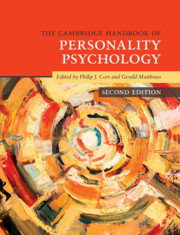Book contents
- The Cambridge Handbook of Personality Psychology
- Cambridge Handbooks in Psychology
- The Cambridge Handbook of Personality Psychology
- Copyright page
- Contents
- Figures
- Tables
- Contributors
- Preface
- General Introduction
- Part I Foundational Issues: History and Approaches to Personality
- Part II Description and Measurement: How Personality Is Studied
- Part III Development, Health and Change: Life Span and Health Outcomes
- Part IV Biological Perspectives: Evolution, Genetics and Neuroscience of Personality
- Part V Cognitive and Motivational Perspectives: Dynamic Processes of Personality
- 21 Cognitive Processes and Models
- 22 Self-Regulation and Control in Personality Functioning
- 23 Basic Needs, Goals and Motivation
- 24 Personality and the Self
- 25 Traits and Dynamic Processes
- 26 Anxiety, Depression and Cognitive Dysfunction
- Part VI Social and Cultural Processes: Personality at the Intersection of Society
- Part VII Applications of Personality Psychology: Personality Traits and Processes in Action
- Addendum: Statistical Analyses and Computer Programming in Personality
- Index
- References
26 - Anxiety, Depression and Cognitive Dysfunction
from Part V - Cognitive and Motivational Perspectives: Dynamic Processes of Personality
Published online by Cambridge University Press: 18 September 2020
- The Cambridge Handbook of Personality Psychology
- Cambridge Handbooks in Psychology
- The Cambridge Handbook of Personality Psychology
- Copyright page
- Contents
- Figures
- Tables
- Contributors
- Preface
- General Introduction
- Part I Foundational Issues: History and Approaches to Personality
- Part II Description and Measurement: How Personality Is Studied
- Part III Development, Health and Change: Life Span and Health Outcomes
- Part IV Biological Perspectives: Evolution, Genetics and Neuroscience of Personality
- Part V Cognitive and Motivational Perspectives: Dynamic Processes of Personality
- 21 Cognitive Processes and Models
- 22 Self-Regulation and Control in Personality Functioning
- 23 Basic Needs, Goals and Motivation
- 24 Personality and the Self
- 25 Traits and Dynamic Processes
- 26 Anxiety, Depression and Cognitive Dysfunction
- Part VI Social and Cultural Processes: Personality at the Intersection of Society
- Part VII Applications of Personality Psychology: Personality Traits and Processes in Action
- Addendum: Statistical Analyses and Computer Programming in Personality
- Index
- References
Summary
One of the few incontrovertible assumptions concerning human personality is that it is influenced and determined by a wide range of factors. Of major importance are individual differences in genetic factors. This was shown very clearly by Vukasović and Bratko (2015) in their meta-analytic review of twin, family and adoption studies designed to assess the percentage of individual differences attributable to genetic factors for major personality factors or dimensions. With respect to H. J. Eysenck’s three orthogonal dimensions of extraversion, neuroticism and psychoticism (see H. J. Eysenck & M. Eysenck, 1985), the percentage figure ranged between 30 percent for psychoticism and 42 percent for neuroticism (which closely resembles trait anxiety).
- Type
- Chapter
- Information
- The Cambridge Handbook of Personality Psychology , pp. 364 - 374Publisher: Cambridge University PressPrint publication year: 2020

